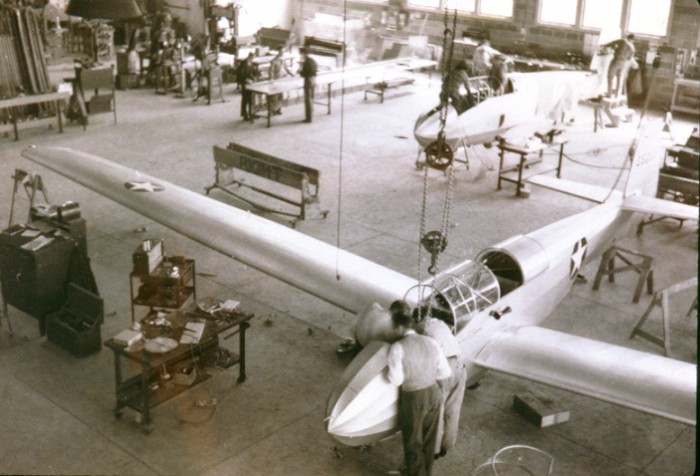Schweizer / SGU 2-12 (TG-3)
Glider Reg. Number: N61279
1943
Design & Development
The Schweizer SGS 2-12 is a two-seat, low-wing, training glider with an all-wooden wing, built by Schweizer Aircraft of Elmira, NY for the Army Air Force to train glider pilots for air assault missions during WWII.
When the U.S. entered WWII in 1941, none of the armed services had a glider program. The German use of glider-borne attack on the Belgian fortress of Eban-Emael and their use in the Battle of Crete, convinced the US military that they would need glider-borne forces of their own.
Initially the USAAF contracted Schweizer for the construction of the existing SGS 2-8, which entered service as the Army TG-2 and the US Navy and US Marine Corps LNS-1. The 2-8 was a good glider trainer, but had fabric-covered aluminum wings. Aluminum was designated as a "strategic material" and its use was to be avoided in training aircraft to conserve it for combat aircraft. Schweizer was therefore asked to design a new glider that would not use aluminum.
Work began on the new model SGS 2-12 in the winter of 1941/42 as production of the 2-8 was getting under way.
The 2-12 had a wooden wing, replacing the aluminum wing on the 2-8. Since the wing was being redesigned, several other improvements requested by the USAAF were incorporated into the design, including simplifying the design for mass production.
The new wing was 2 feet greater in span, giving it a slightly better glide ratio than the 2-8. The greater span also helped make up for the additional weight of the aircraft. Typical empty weights were almost double that of the 2-8 at 860 lbs (390 kg).
The wing was also thicker in section, with a thicker spar, which allowed the elimination of the struts that the 2-8 had used, while permitting a higher redline speed. The wing was also moved from a mid-wing position to a low-wing, to improve the instructor's visibility from the rear cockpit. The new wing also incorporated balanced top and bottom surface divebrakes, replacing the 2-8's top surface spoilers.
The 2-12 has a welded steel tube fuselage covered in aircraft fabric. The wooden wings are also covered in aircraft fabric.
The 2-12 received type certificate G-2-11 after the war was over, on 27 February 1947. All aircraft are officially FAA certificated as TG-3As, rather than SGS 2-12s
A total of 113 TG-3As were built for USAAF use, including three XTG-3 prototypes. One TG-3A was constructed by Air Glider as part of an order for 50 TG-3As, but that company's contract performance was not acceptable to the USAAF and further orders were cancelled.
All remaining military TG-3As were sold to gliding schools and individuals at the end of the war. One civil SGS 2-12 was completed by Schweizer for factory use at the very end of the military TG-3A production line, bringing the total completed to 114.
The SGS 2-12 is a large and heavy glider. It is also difficult and time-consuming to remove the wings for trailering or storage. After the war, when many were in civil service these factors resulted in many being tied down outside, rather than being protected in trailers. The wooden wings on many suffered deterioration as a result of exposure to the weather
On November 4, 1945 Frank Hurtt and Paul A. Schweizer broke the multi-place duration record in a TG-3A. The flight was flown at Harris Hill in ridge lift and lasted 9 hours and 17 minutes and was the first post war record set in the USA.
In 1950 Harland Ross set a new altitude record with a 2-12 flight to 36,100 feet (11,003 m)
Betsy Woodward set the woman's altitude record in a 2-12 as well
The NSM TG-3 was donated in 1983 by Les Arnold. It was o n display at the Elmira Regional Airport terminal until returned to the museum in May 2017.
n display at the Elmira Regional Airport terminal until returned to the museum in May 2017.
Specifications
Total Number Built: 115
Span: 54 ft 16.46 m
Length: 27.6 ft 8.42 m
Wing Area: 237 ft2 22.02 m2
Empty Weight: 860 lbs 390 kg
Wing Loading: 5.05 lbs/ft2 24.6 kg/m2
Glide Ratio (est.): 24:1 @ 52 mph 83.9 km/h
Minimum rate of sink: 3 ft/sec @ 52 mph 0.91 m/sec @ 83.8 km/h